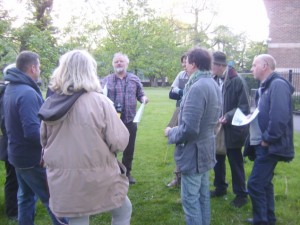Recently a group of people of people from Farnborough Crondal, Godalming, Lightwater, Frimley, Woking, Fleet and Southampton met in Farnborough to explore:-
• why some trees had very twisted branches which could not be accounted as vandalism or being affected by the prevailing wind
• what happened to a possible fountain
• what happened to a large stone which was possible moved fifty seven years ago
• the alignment of underground water channels
• What connections if any where there with the Albert Road Tumulus.
• A pedestrian tunnel which passes under the A325; now blocked off.
All this was happening within a few metres of the Farnborough Road. Their search tools were their minds, a piece of bent wire and a variety of pendulums used to apply a range of dowsing skills.
A few members of the passing public were intrigued and they were given a one minute introduction to the skills being used and shown how the mind controls the tools.
Were the Groups called Waverley dowsers satisfied with their evenings work? Well only partly. That was in spite of a Google earth study of the area and pre-survey work over three weekends.
The site is the open space at the junction of Boundary Road and Farnborough Road and readers are asked to contact the Newspaper if they have knowledge/picture of a [standing] stone in this location.
It is believed that there was a fountain in the grounds of the house which had been constructed on the site. The Group found what might be the feed pipe but they have yet to return to complete their search.
The issue of the underground water sources needs further investigation. If anyone wishes to acquire the skills to do this sort of research they would be welcome at Waverley Dowsers or a group like the Hampshire Archaeological Dowsers.
In this picture we see Ken Collinson explaining how a glacial pan affects underground water flow. The flow from this and similar geological formations produce a subtle electrical energy which can affect the growth of trees and human. Most of the “time team” agreed that underground energies were responsible for the twists in the trees.
 Ken Collinson [wearing a scarf] addressing the group about the glacial period and its effect on dowsable water flows and the subtle energy currents.
Ken Collinson [wearing a scarf] addressing the group about the glacial period and its effect on dowsable water flows and the subtle energy currents.
These flows are dowsable and in the case of “sick building syndrome” a specialist dowser will dowse to locate them and try reduce their potency.
Ken, from Frimley manages the Groups web site. His knowledge was complemented by Geoff Mitchell, an electronics engineer from Lightwater. He did most of the Google Earth research and planning for the evening.
Light stopped play but not before the group had a head to head to pool their observations and to do an outline plan for visit two.
That visit might also include an attempted to mark the entrance to an ice house on a separate site, nearby.
Mike Haxetline said that “some of the trees were already protected by current protection legislation. However this site represents possibly one of the most importance examples of trees deformations caused by underground water flows, in the South east of England”.
Michael also said “that the trees affected can be clearly seen from the road”. More work is needed on the area to see what heightened levels of protection are needed for this interesting area of environmental science. Michael has in his second book identified 26 different reasons for trees deforming.
For more information about Waverley dowsers contact Michael on 01252 541 639 of the Current Chairman Geoff 01276 472977
Waverley Dowsers will return to this site for further investigation not only for the tree deformities but to help locate various missing Neolithic stones and the relation between this site, the Albert road Tumulus, the two tumulus on Queens roundabout at the end of Lynchford road and the demolished neolithic stone circle that was once in the vicinity behind Victoria road in Farnborough.
For the article on the completed first investigation by Waverley dowsers at Farnborough, please read the full report HERE
You must be logged in to post a comment.